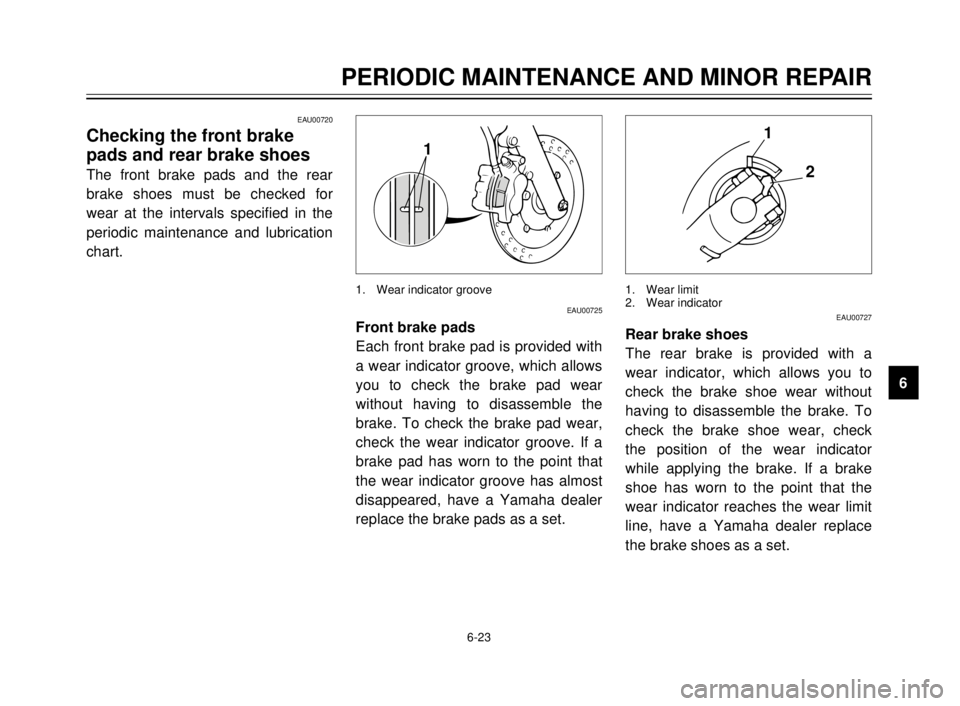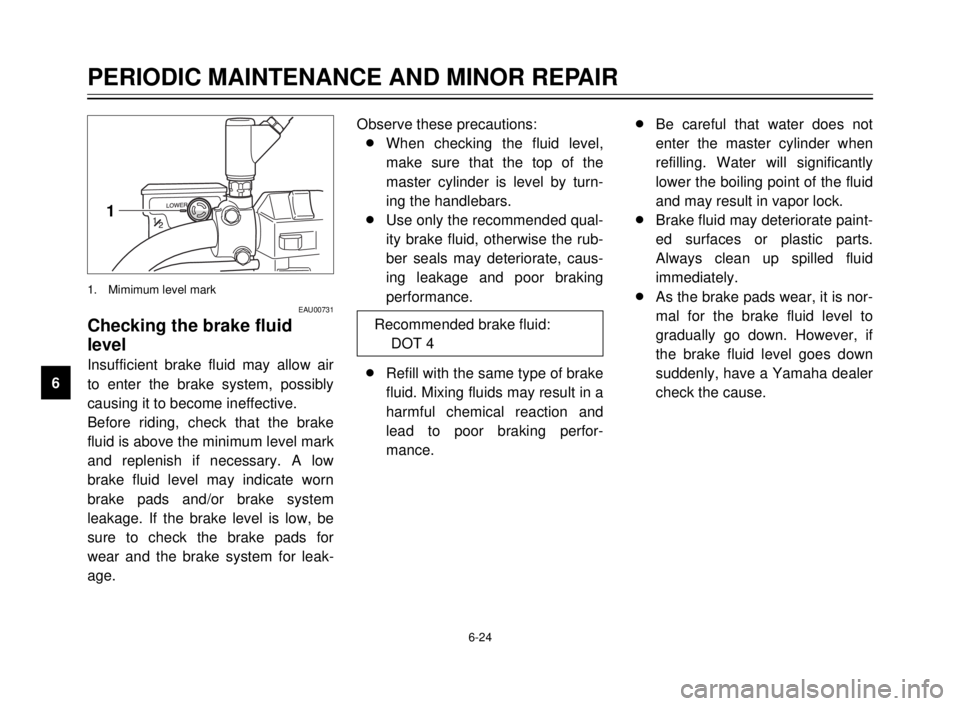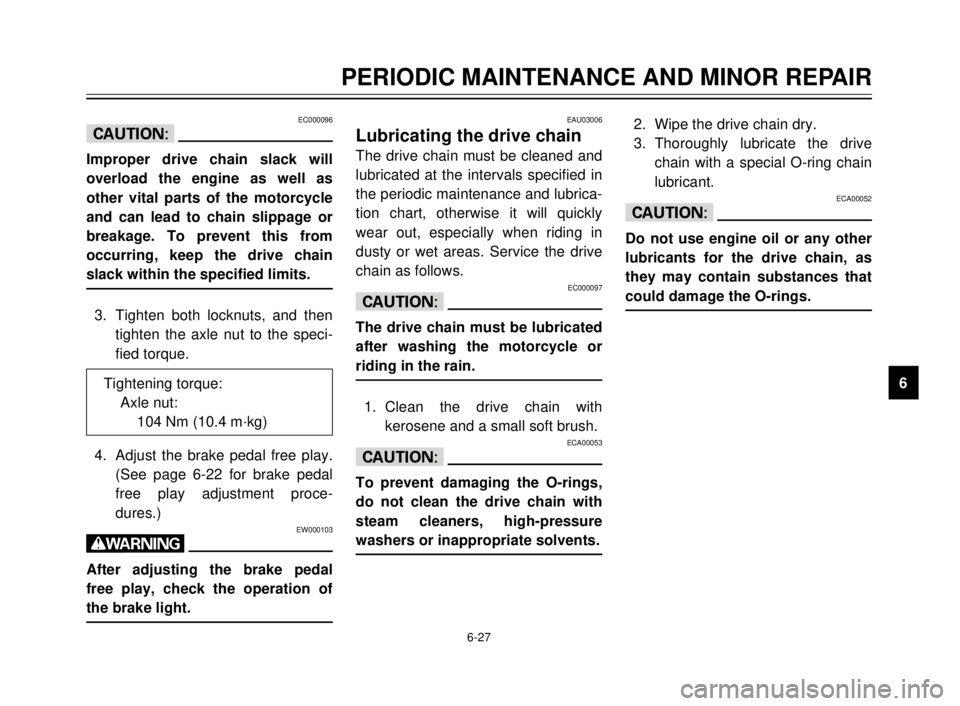YAMAHA XVS125 2000 Workshop Manual
Manufacturer: YAMAHA, Model Year: 2000, Model line: XVS125, Model: YAMAHA XVS125 2000Pages: 86, PDF Size: 3.07 MB
Page 51 of 86

1
2
3
4
5
6
7
8
9
6-21
PERIODIC MAINTENANCE AND MINOR REPAIR
EW000099
w
8After adjusting the brake lever
free play, check the free play
and make sure that the brake
is working properly.
8A soft or spongy feeling in the
brake lever can indicate the
presence of air in the
hydraulic system. If there is air
in the hydraulic system, have
a Yamaha dealer bleed the
system before operating the
motorcycle. Air in the
hydraulic system will diminish
the braking performance,
which may result in loss of
control and an accident.
EAU01199
Adjusting the brake pedal
position and free play
EW000104
w
It is advisable to have a Yamaha
dealer make these adjustments.
Brake pedal position
The top of the brake pedal should be
positioned approximately 76.6 mm
above the top of the footrest as
shown. Periodically check the brake
pedal position and, if necessary,
adjust it as follows.1. Loosen the locknut at the brake
pedal.
2. To raise the brake pedal, turn the
adjusting bolt in direction a. To
lower the brake pedal, turn the
adjusting bolt in direction b.
3. Tighten the locknut.
EW000105
w
After adjusting the brake pedal
height, the brake pedal free play
must be adjusted.
1
a
2
b
1. Brake pedal position adjusting bolt
2. Locknut
1
b
a
1. Footrest
a. Distance between brake pedal and footrest
b. Brake pedal free play
5JX-9-E0 4/9/0 4:11 AM Page 49
Page 52 of 86

6-22
1
2
3
4
5
6
7
8
9
PERIODIC MAINTENANCE AND MINOR REPAIR
Brake pedal free play
The brake pedal free play should
measure 20–30 mm at the brake
pedal end. Periodically check the
brake pedal free play and, if neces-
sary, adjust it as follows.
To increase the brake pedal free
play, turn the adjusting nut at the
brake rod in direction a. To
decrease the brake pedal free play,
turn the adjusting nut in direction b.
1. Brake pedal free play adjusting nut
1
b a
EW000106
w
8After adjusting the drive chain
slack or removing and
installing the rear wheel,
always check the brake pedal
free play.
8If proper adjustment cannot be
obtained as described, have a
Yamaha dealer make this
adjustment.
8After adjusting the brake pedal
free play, check the operation
of the brake light.
EAU00713
Adjusting the rear brake light
switch
The rear brake light switch, which is
activated by the brake pedal, is prop-
erly adjusted when the brake light
comes on just before braking takes
effect. If necessary, adjust the brake
light switch as follows.
Turn the adjusting nut while holding
the rear brake light switch in place.
To make the brake light come on ear-
lier, turn the adjusting nut in direction
a. To make the brake light come on
later, turn the adjusting nut in direc-
tion b.
1. Rear brake light switch
2. Adjusting nut
1
2
b
a
5JX-9-E0 4/9/0 4:11 AM Page 50
Page 53 of 86

1
2
3
4
5
6
7
8
9
6-23
PERIODIC MAINTENANCE AND MINOR REPAIR
EAU00720
Checking the front brake
pads and rear brake shoes
The front brake pads and the rear
brake shoes must be checked for
wear at the intervals specified in the
periodic maintenance and lubrication
chart.
EAU00725
Front brake pads
Each front brake pad is provided with
a wear indicator groove, which allows
you to check the brake pad wear
without having to disassemble the
brake. To check the brake pad wear,
check the wear indicator groove. If a
brake pad has worn to the point that
the wear indicator groove has almost
disappeared, have a Yamaha dealer
replace the brake pads as a set.
1. Wear indicator groove
1
EAU00727
Rear brake shoes
The rear brake is provided with a
wear indicator, which allows you to
check the brake shoe wear without
having to disassemble the brake. To
check the brake shoe wear, check
the position of the wear indicator
while applying the brake. If a brake
shoe has worn to the point that the
wear indicator reaches the wear limit
line, have a Yamaha dealer replace
the brake shoes as a set.
1. Wear limit
2. Wear indicator
1
2
5JX-9-E0 4/9/0 4:11 AM Page 51
Page 54 of 86

6-24
1
2
3
4
5
6
7
8
9
PERIODIC MAINTENANCE AND MINOR REPAIR
EAU00731
Checking the brake fluid
level
Insufficient brake fluid may allow air
to enter the brake system, possibly
causing it to become ineffective.
Before riding, check that the brake
fluid is above the minimum level mark
and replenish if necessary. A low
brake fluid level may indicate worn
brake pads and/or brake system
leakage. If the brake level is low, be
sure to check the brake pads for
wear and the brake system for leak-
age.
1. Mimimum level mark
1
Observe these precautions:
8When checking the fluid level,
make sure that the top of the
master cylinder is level by turn-
ing the handlebars.
8Use only the recommended qual-
ity brake fluid, otherwise the rub-
ber seals may deteriorate, caus-
ing leakage and poor braking
performance.
8Refill with the same type of brake
fluid. Mixing fluids may result in a
harmful chemical reaction and
lead to poor braking perfor-
mance.8Be careful that water does not
enter the master cylinder when
refilling. Water will significantly
lower the boiling point of the fluid
and may result in vapor lock.
8Brake fluid may deteriorate paint-
ed surfaces or plastic parts.
Always clean up spilled fluid
immediately.
8As the brake pads wear, it is nor-
mal for the brake fluid level to
gradually go down. However, if
the brake fluid level goes down
suddenly, have a Yamaha dealer
check the cause. Recommended brake fluid:
DOT 4
5JX-9-E0 4/9/0 4:11 AM Page 52
Page 55 of 86

1
2
3
4
5
6
7
8
9
6-25
PERIODIC MAINTENANCE AND MINOR REPAIR
EAU03238
Changing the brake fluid
Have a Yamaha dealer change the
brake fluid at the intervals specified in
the periodic maintenance and lubrica-
tion chart. In addition, have the oil
seals of the brake master cylinder
and caliper as well as the brake hose
replaced at the intervals listed below
or whenever it is damaged or leaking.
8Oil seals: Replace every two
years.
8Brake hose: Replace every four
years.2. Shift the transmission into the
neutral position.
3. Move the rear wheel by pushing
the motorcycle to locate the tight-
est portion of the drive chain,
and then measure the drive
chain slack as shown.
4. If the drive chain slack is incor-
rect, adjust it as follows.
EAU00744
Drive chain slack
The drive chain slack should be
checked before each ride and adjust-
ed if necessary.
To check the drive chain slack
1. Place the motorcycle on a level
surface and hold it in an upright
position.
NOTE:
When checking and adjusting the
drive chain slack, the motorcycle
should be positioned straight up and
there should be no weight on it.
a. Drive chain slack
a
Drive chain slack:
30–40 mm
5JX-9-E0 4/9/0 4:11 AM Page 53
Page 56 of 86

6-26
1
2
3
4
5
6
7
8
9
PERIODIC MAINTENANCE AND MINOR REPAIR
EAU03187
To adjust the drive chain slack
1. Loosen the brake pedal free play
adjusting nut, the axle nut, and
the chain puller locknut at each
end of the swingarm.
1. Brake pedal free play adjusting nut
2. Drive chain puller locknut
2
1
1. Axle nut
1
2. To tighten the drive chain, turn
the adjusting nut at each end of
the swingarm in direction a. To
loosen the drive chain, turn the
adjusting nut at each end of the
swingarm in direction b, and
then push the rear wheel for-
ward.
NOTE:
Using the alignment marks on each
side of the swingarm, make sure that
both adjusting nuts are in the same
position for proper wheel alignment.
1. Alignment marks
2. Drive chain adjusting nut
3. Locknut
312
b
a
5JX-9-E0 4/9/0 4:11 AM Page 54
Page 57 of 86

1
2
3
4
5
6
7
8
9
6-27
PERIODIC MAINTENANCE AND MINOR REPAIR
EAU03006
Lubricating the drive chain
The drive chain must be cleaned and
lubricated at the intervals specified in
the periodic maintenance and lubrica-
tion chart, otherwise it will quickly
wear out, especially when riding in
dusty or wet areas. Service the drive
chain as follows.
EC000097
cC
The drive chain must be lubricated
after washing the motorcycle or
riding in the rain.
1. Clean the drive chain with
kerosene and a small soft brush.
ECA00053
cC
To prevent damaging the O-rings,
do not clean the drive chain with
steam cleaners, high-pressure
washers or inappropriate solvents.
EC000096
cC
Improper drive chain slack will
overload the engine as well as
other vital parts of the motorcycle
and can lead to chain slippage or
breakage. To prevent this from
occurring, keep the drive chain
slack within the specified limits.
3. Tighten both locknuts, and then
tighten the axle nut to the speci-
fied torque.
4. Adjust the brake pedal free play.
(See page 6-22 for brake pedal
free play adjustment proce-
dures.)
EW000103
w
After adjusting the brake pedal
free play, check the operation of
the brake light.
Tightening torque:
Axle nut:
104 Nm (10.4 m·kg)
2. Wipe the drive chain dry.
3. Thoroughly lubricate the drive
chain with a special O-ring chain
lubricant.
ECA00052
cC
Do not use engine oil or any other
lubricants for the drive chain, as
they may contain substances that
could damage the O-rings.
5JX-9-E0 4/9/0 4:11 AM Page 55
Page 58 of 86

6-28
1
2
3
4
5
6
7
8
9
PERIODIC MAINTENANCE AND MINOR REPAIR
EAU02962
Checking and lubricating the
cables
The operation of all control cables
and the condition of the cables
should be checked before each ride,
and the cables and cable ends
should be lubricated if necessary. If
a cable is damaged or does not move
smoothly, have a Yamaha dealer
check or replace it.
EW000112
w
Damage to the outer sheath may
interfere with proper cable opera-
tion and will cause the inner cable
to rust. Replace a damaged cable
as soon as possible to prevent
unsafe conditions.
EAU03199
Checking and lubricating the
brake and shift pedals
The operation of the brake and shift
pedals should be checked before
each ride, and the pedal pivots
should be lubricated if necessary.
Recommended lubricant:
Lithium-soap-based grease
(all-purpose grease)
Recommended lubricant:
Engine oil
5JX-9-E0 4/9/0 4:11 AM Page 56
Page 59 of 86

1
2
3
4
5
6
7
8
9
6-29
PERIODIC MAINTENANCE AND MINOR REPAIR
EAU03164
Checking and lubricating the
brake and clutch levers
The operation of the brake and clutch
levers should be checked before
each ride, and the lever pivots should
be lubricated if necessary.
EAU03165
Checking and lubricating the
sidestand
The operation of the sidestand
should be checked before each ride,
and the sidestand pivot and metal-to-
metal contact surfaces should be
lubricated if necessary.
EW000113
w
If the sidestand does not move up
and down smoothly, have a
Yamaha dealer check or repair it.
EAU02939
Checking the front fork
The condition and operation of the
front fork must be checked as follows
at the intervals specified in the peri-
odic maintenance and lubrication
chart.
To check the condition
EW000115
w
Securely support the motorcycle
so that there is no danger of it
falling over.
Check the inner tubes for scratches,
damage and excessive oil leakage.
Recommended lubricant:
Lithium-soap-based grease
(all-purpose grease)
Recommended lubricant:
Lithium-soap-based grease
(all-purpose grease)
5JX-9-E0 4/9/0 4:11 AM Page 57
Page 60 of 86

6-30
1
2
3
4
5
6
7
8
9
PERIODIC MAINTENANCE AND MINOR REPAIR
To check the operation
1. Place the motorcycle on a level
surface and hold it in an upright
position.
2. While applying the front brake,
push down hard on the handle-
bars several times to check if the
front fork compresses and
rebounds smoothly.
EC000098
cC
If any damage is found or the front
fork does not operate smoothly,
have a Yamaha dealer check or
repair it.
2. Hold the lower ends of the front
fork legs and try to move them
forward and backward. If any
free play can be felt, have a
Yamaha dealer check or repair
the steering.
EAU00794
Checking the steering
Worn or loose steering bearings may
cause danger. Therefore, the opera-
tion of the steering must be checked
as follows at the intervals specified in
the periodic maintenance and lubrica-
tion chart.
1. Place a stand under the engine
to raise the front wheel off the
ground.
EW000115
w
Securely support the motorcycle
so that there is no danger of it
falling over.
5JX-9-E0 4/9/0 4:11 AM Page 58